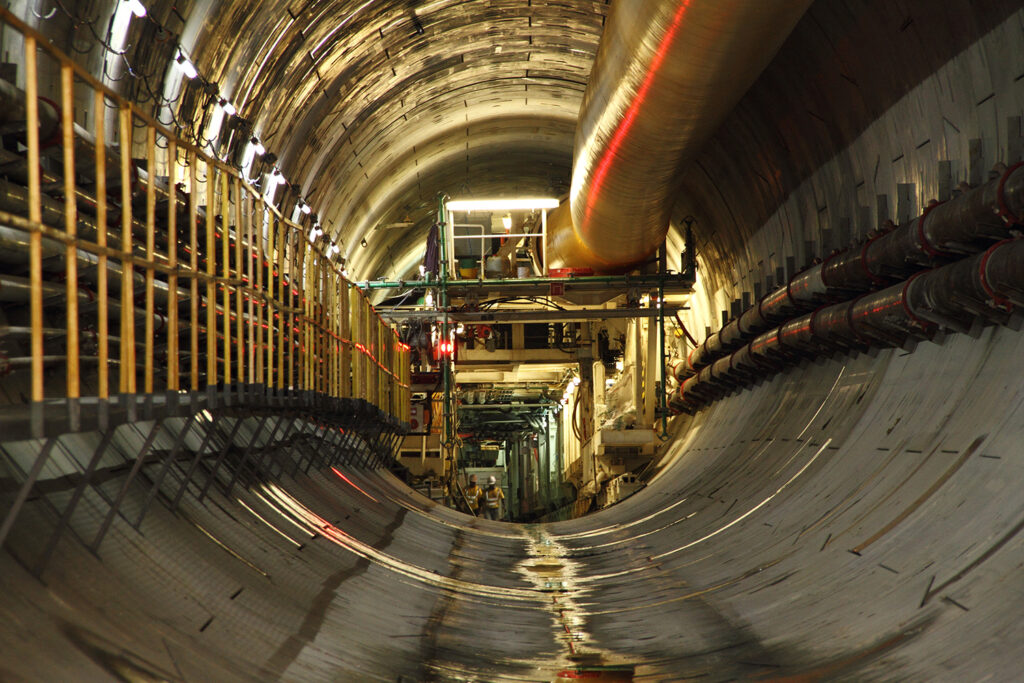It was December 2019, two tunnel engineers were faced with the daunting task of analysing hundreds of data mined from Gamuda’s sprawling tunnelling operations. One tunnel boring machine alone collects data from over 400 sensors with different parameters. With multiple machines running simultaneously on a project like the KVMRT Putrajaya Line, it was a recipe for information overload.
Speaking to one of the engineers, Lee Sze Tyng reflects on their journey 3 years back that eventually led to the creation of Tunnel Insight.

Pioneers of their time: John Lim Ji Xiong (left), Bryan Chua Seck How (not in picture) and Lee Sze Tyng (center) as developers, Liew Kit Shen (right) and Mohamad Kamil bin Idris (not pictured) for data acquisition.
Tunnel Insight (TI) is a unified management tunnelling application that provides a centralised, user-friendly platform integrated with cutting-edge technologies like Big Data, Cloud Computing, and Artificial Intelligence. With access to categorised data in real time, the system would enable efficient and simplified administration.
Six months later with a larger crew of five, the beta version of Tunnel Insight was ready for testing. As more tunnelling data is accumulated, Tunnel Insight became an important resource for improving construction performance, increasing situational awareness and granting in-depth assessments of complex underground terrains.
Why build in-house?
It was clear from the outset that the team would have to build the solution in-house. Existing software was costly and didn’t easily provide the customisation that they were looking for. By default, software were already working in tandem but not talking to one another. For example, there could be one for navigation or TBM parameters, another for reporting and so on. To make things worse, some data were only accessible from a single computer in the office, making reporting across different sites extremely tedious.
To create the ultimate holy grail of tunnelling data management- the team envisioned a plug-and-play solution that could be connected to any TBMs for data collection and real-time analysis.

Single glance dashboard of the TBM’s progress per shift – completely automated and zero human input needed.
Building in-house also meant they could actively workshop new features in league with tunnelling experts. For example, the original format of shift reports used to only show information of daily events but was eventually supplemented with weekly summaries by request from senior managers.
360 insight° from 20 meters below ground
Leveraging on Artificial Intelligence technology, they had also trained and deployed machine learning models to analyse new data, identify trends and outliers as tunnelling progresses. Apart from informing project wide planning, these grant decision-makers much needed confidence, especially in contingencies involving multiple TBMs and sites.

If the data indicates that the cutting equipment is wearing out faster than usual, an intervention can be staged earlier to minimise disruptions.
Malaysia and beyond
Sze Tyng revealed that scaling the application is the next priority in line.
“We want to use Tunnel Insight for a full project life cycle while expanding its functionality”
Tunnel Insight will eventually be the one-stop center managing tunnelling projects around the world simultaneously. Recent projects secured by Gamuda, such as Singapore’s Defu Station and Tunnels project and Australia’s Sydney Metro West Project had already expressed keen interest to harness the benefits of Tunnel Insight.
As demand for sustainable development grow, solutions like Tunnel Insight become key enablers to creating safe underground spaces and infrastructures.
Gamuda Berhad is Malaysia’s leading engineering and infrastructure company that had shaped the nation’s foray into mega tunnel infrastructures. Gamuda had delivered complex projects like the Stormwater Management and Road Tunnel (SMART) and Klang Valley Mass Rapid Transit underground lines, where the world’s first Autonomous Tunnel Boring Machine was introduced. Tunnel boring machines (TBMs) are the workhorse for such massive undertakings, building tunnels 6 to 13 meters in diameter beneath urban environments.




